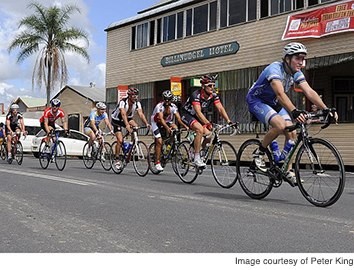So your mates talked you into joining them in the 160km (100 miles) Gran Fondo: rough roads and 2,000 metres (2,560') of climbing await you. And while surrounded by the mutual testosterone, you feel courageous and invincible. That is, until home time and you come to the lonely realisation of the pain, sweat and cramps to come.
When I first started riding, these same macho men told to "Just ride through the cramp!" Yeah right, easily said, but when your legs are so cramped they stick out perpendicular to your bike like the struts on a set of training wheels, I feel it is certainly okay to wish a curse upon them as you negotiate getting off your bike without falling in a very painful heap.
So then, preparation! I have had friends end up sick in bed for days with dehydration and heat stroke after particularly gruelling rides. Our bodies are designed to survive on natural food and water alone, but God also gave us the brains to develop alternatives just in case we used those brains to think up ingenious ways to suffer unnecessarily - like for instance, pedalling a bike consistently for over six hours.
.jpg) Obviously hydration is an essential part of preparation. It is always a good idea to carry water, and if you are consuming gels, it is a necessity. Saying that, when it gets really hot, water cannot replace everything that your body is losing through perspiration. Your stomach will also not be able to process the amount of water needed to balance the losses.
Obviously hydration is an essential part of preparation. It is always a good idea to carry water, and if you are consuming gels, it is a necessity. Saying that, when it gets really hot, water cannot replace everything that your body is losing through perspiration. Your stomach will also not be able to process the amount of water needed to balance the losses.
The answer is to carry a bottle of electrolyte drink. It replaces salts and minerals, helps keep you running efficiently and prevents cramping muscles. The best practice I believe is to purchase electrolyte powder in a tin and premix your riding bottles at home. It is cost-effective and makes staying hydrated a part of the daily routine.
It is also good to have recovery powders on hand for when you finish that tough training session. These will aid rehydration and also help with muscle repair and recovery. I am a big fan of citrus flavoured recovery drinks after a long day in the saddle as they freshen you up with a lemony tang!
There are several different types of nutrition products available specifically designed for endurance sporting activities like cycling. Gels and bars stow neatly in your jersey pockets and are easy to eat on the bike. These products are brilliant at replacing energy in the form of simple and complex carbohydrates. On a long ride it is best to eat at least every 40 minutes and I think there is a lot of wisdom in the old adage “eat before you’re hungry, drink before you’re thirsty".
I personally prefer gels because you don't have to chew and I find them easier to digest when my stomach feels all weird after long hours of riding. Always consume gels with water. A simple strategy is to tape a few gels along the top tube of your bike, it keeps them within easy reach and helps you to stay mindful of eating consistently.
There are also top tube-mounted 'tri bags' which are great for storing nutrition. I like to leave the caffeine-filled, coffee-flavoured gel to the end of a race as a treat. Plus, it wakes you up for that last effort. Near the finish line, dehydration probably isn't quite as great a concern.
Once nutrition and hydration are taken care of it is time to look at the bike. First tip: get it serviced early on! In my many years working in bike shops, we were always amazed at the amount of people coming in just a day or two before the big event wanting a bike service. We sometimes found a major issue but with no time to appropriate parts to fix it. So, get your bike serviced a couple of weeks out and spare everyone a lot of pain!

As for equipment, the same rules apply as for general riding i.e.: spare tubes, pump, tyre levers, and mini tool. I have a couple of suggestions born from experience: Firstly, get a mini tool with a chain breaker and learn how to use it. Carry a couple of spare links as well just in case. This is important for MTBer’s but also roadies (my work mate snapped his chain just the other day on a road ride). My other suggestion is to carry a CO2 regulator and spare cartridges. If you get a flat (let’s face it on a road bike you always do!) there is no quicker way to get moving again. It is very annoying seeing fellow competitors, (that you would really like to beat), zoom past while you squat there pumping a road pump with a chamber the size of a HB pencil.
All you need to do now is get out and ride, which itself is a subject for another day. I like to keep it simple: if it’s a hilly race, train in the hills. If it’s a mountain bike race, train on your mountain bike in the forest…easy eh?
So go ahead: Train hard, eat well, drink well and maybe show the macho men how to ride a bike. And maybe next time, it will be your turn to say: "Just ride through the cramp, mate"!


